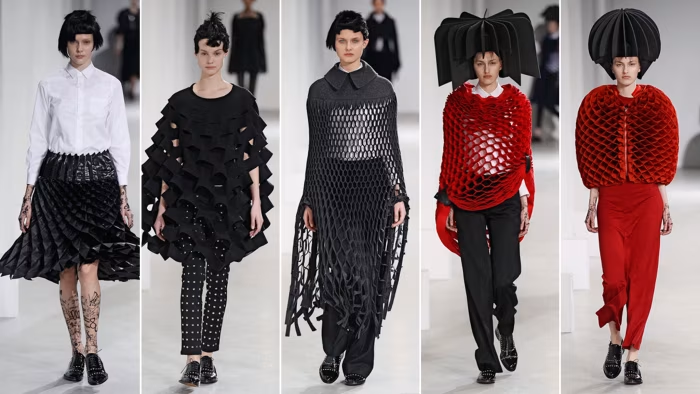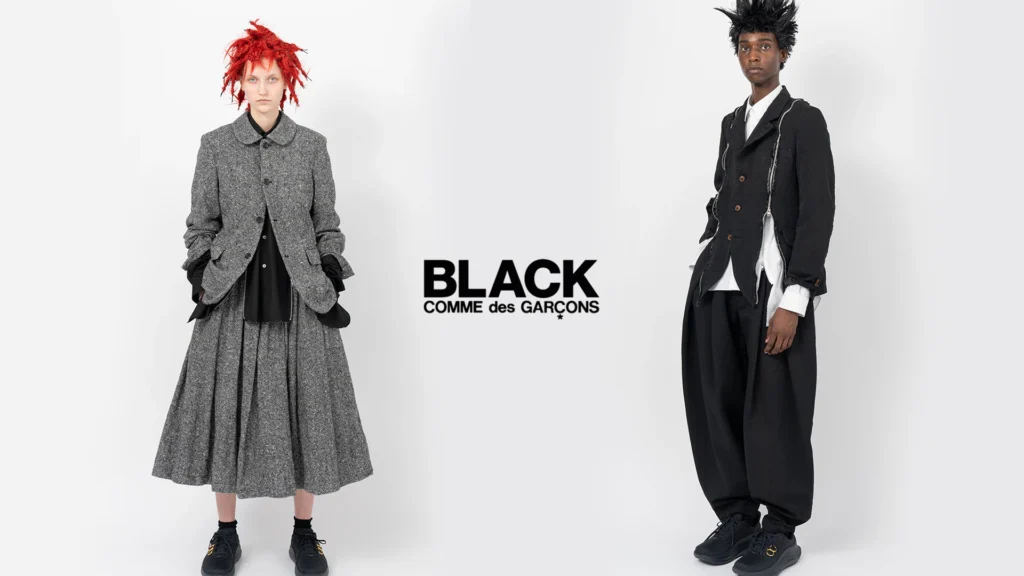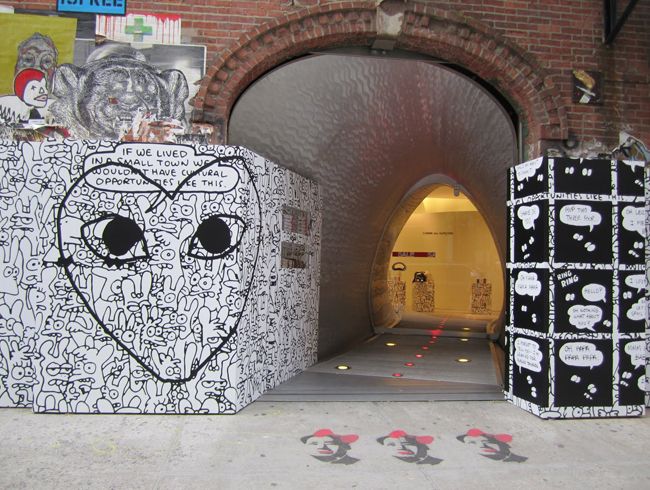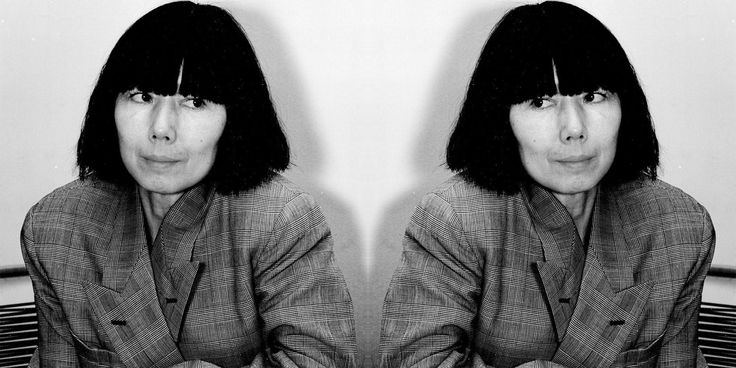Introduction: The Legacy of Rei Kawakubo’s Creative Empire
When people speak of Comme des Garcons, they often think of its visionary founder, Rei Kawakubo — the designer who redefined what fashion could mean. But within her creative universe, two names stand out as the brightest stars who have carried her avant-garde legacy into new frontiers: Junya Watanabe and Kei Ninomiya.
Both designers began their journeys under Kawakubo’s mentorship, emerging from the Comme des Garçons atelier in Tokyo before establishing their own labels — Junya Watanabe Comme des Garçons and Noir Kei Ninomiya. Together, they embody the evolution of Kawakubo’s philosophy: experimentation, craftsmanship, and the courage to break convention.
This article explores how Junya Watanabe and Kei Ninomiya became two of the most influential designers of their generation, continuing the spirit of Comme des Garçons’ avant-garde innovation while carving distinct creative paths.
The Comme des Garcons School of Design
Rei Kawakubo’s Mentorship Philosophy
Rei Kawakubo is more than a designer; she is an architect of culture. Comme des Garcons has fostered several proteges under her leadership, whereby independence and intellectual freedom are promoted.
Her mentorship philosophy is based on trust, independence, and conceptual ideas. The proteges of Kawakubo are not instructed on what to do; they are stimulated to discover their own rhetoric of creativity. That is why her atelier has brought some of the most creative designers in modern fashion that no one more notable including Junya Watanabe and Kei Ninomiya.
The DNA of Comme des Garcons
The work by Watanabe and Ninomiya cannot be comprehended without first knowing the essence of the Comme des Garcons DNA:
- Deconstruction/ reconstruction – problematizing the construction of garments.
- Idea over form– giving precedence to intellectual concepts over form and beauty.
- Monochrome and shape – experimenting with no color, arrangement, or texture.
- Fluidity to gender – denying the conventional boundaries of masculine and feminine fashion.
Watanabe and Ninomiya shared these concepts but developed them quite differently, which demonstrates that the Comme des Garcons philosophy is not a set of rules, and it is a living idea.
Junya Watanabe: The Engineer of Avant-Garde Fashion
Early Life and Apprenticeship
Junya Watanabe was born in 1961 in Fukushima, Japan, and enrolled in Comme des Garcons right after leaving the Bunka Fashion College in 1984, which was the school that produced Rei Kawakubo and Yohji Yamamoto.
Watanabe started off as a patternmaker in Comme des Garcons Tricot and became known because of his technical accuracy and creative problem-solving. He had learned the art of construction under Kawakubo, mentoring him so that he treated garments as a blueprint of an architectural building, as opposed to a decoration.
Launching His Own Line
In 1992, Kawakubo urged Watanabe to produce his own brand under the Comme des Garcons brand. This way, Junya Watanabe Comme des Garcons was created.
Since its inception, the work of Watanabe has been characterized by conceptual craftsmanship – how clothes can be manufactured with the use of new technologies, fabrics, and modules. His lines have been termed as techno couture, learned yet very comfortable to wear.
The Aesthetic of Junya Watanabe
The aesthetic of Watanabe can be characterized as the amalgamation of the past and the future. Where Rei Kawakubo was deconstructing the form, Watanabe was concentrating on reconstruction – making clothes out of unusual forms or making them of contrasted materials like denim, nylon, or leather.
He has partnered with large international brands such as Levi’s, The North Face, and New Balance, and combined cutting-edge tailoring with utilitarianism. This talent to combine high concept and streetwear sense has made him a link between the intellectualism of Comme des Garcons and the pragmatism of modernity.
Technology, Fabric, and Form
Watanabe has a reputation for having an engineering mind. His work frequently incorporates three-dimensional drapery, laser cutting, and cloth development, and experiments with the relationship between human anatomy and mechanical accuracy.
He once said:
I have no particular interest in design as design. I would be interested in creation by means of engineering.
The philosophy has turned Junya Watanabe Comme des Garcons into the epitome of technical expertise and future craft, showing that fashion innovation can be both conceptual and practical.
Noir Kei Ninomiya: The New Voice of Darkness
The Next Generation of Comme des Garcons
Junya Watanabe, the architectural engineer of the Comme des Garcons world, is the sculptural poet of the darkness of the world. Ninomiya was born in 1982 in Japan, where he studied French literature, then moved on to fashion design at the Royal Academy of Fine Arts in Antwerp where he studied, one of the most experimental art schools in Europe.
Ninomiya began working with Comme des Garcons in 2008 as a patternmaker under Rei Kawakubo, where he worked for a number of years. His detail and skills made her notice him, and in 2012, she gave him the autonomy to start his own brand under the company: Noir Kei Ninomiya.
The Meaning of “Noir”
The philosophical and visual reality of the design language used by Kei Ninomiya is observed in the word Noir, meaning black in French. To Ninomiya, black is not only a color but a canvas to be experimented with. It symbolizes order, passion, and chastity in art.
Ninomiya chooses to work predominantly in black, and this helps to draw the attention of the viewer more to form, material and light and how clothes may become sculptures.
Design Philosophy and Aesthetic
In contrast to the traditional construction of the garment, Noir Kei Ninomiya frequently does not sew his garments at all. Ninomiya favors modular methods – interconnecting small pieces like metal rings, plastic clips or fabric petals in order to create clothing bit by bit.
This practice transforms the clothing into a three-dimensional structure, which questions the distinction between the dress and the sculpture. Both collections reflect a different interpretation of touch, tension, and relationship, where craftsmanship is given precedence over adornment.
Feminine Strength Through Structure
Even though Rei Kawakubo in terms of her aesthetics would tend to explore the theme of androgyny, the work of Kei Ninomiya introduces a new meaning of feminine power. His designs also have delicate though powerful constructions – armored dresses of tulle, leather, or metal.
His conception of femininity is not frail; it is strong, clever, and structural. The re-conceptualization of feminine strength fits the philosophy Comme des Garcons of deconstructing societal conventions via design.
Shared Ideals, Distinct Identities
The Influence of Rei Kawakubo
Junya Watanabe, as well as Kei Ninomiya, owes a lot to the philosophy of Rei Kawakubo, who thought of fashion as a means of ideas, rather than being merely about looks. Never did Kawakubo ask to be imitated, however. Rather, she fostered autonomy so that every designer established his or her creative voice.
This is the reason why, though they both have the Comme des Garcons tradition, the works of Watanabe and Ninomiya are different; one is more engineering and functional, and the other is more emotional and structural.
Technical Innovation vs. Artistic Construction
- Junya Watanabe: Deals in technology, pattern design, and industrial materials. He is an analytical person; he makes clothes like a machine.
- Kei Ninomiya: Handcraft, repetition, and modular works. His method is poetic – he makes clothes like sculptures.
They are two extremes of the creative spectrum of Comme des Garçons, extending the brand history to the individual level of innovation.
Cultural Impact and Global Recognition
Influence on Contemporary Fashion
Both Watanabe and Ninomiya have contributed to reinventing the concept of Japanese avant-garde fashion on the international platform. Their lines are presented regularly at the Paris Fashion Week, where they still confront the Western definition of luxury and beauty.
Watanabe has opened the door of the avant-garde thoughts to ordinary consumers, and Ninomiya has shown his couture-like skills in appealing to collectors and art lovers.
Their creations show that the Comme des Garcons ethos or spirit of conceptual, intellectual, and fearless is still topical today as it was in the early days of Rei Kawakubo.
Critical Acclaim
Watanabe has received acclaim for technical ingenuity and his capability of combining the very practical with the poetic, and Ninomiya has been heralded as one of the brightest young designers of the 21st century, who has made black talk.
Both of the designers can be described as being part of what fashion designers refer to as The Comme des Garcons School of thought – a school of thought of designers who believe in ideas over trends, change over conformity, and art over commerce.
Conclusion: The Future of the Comme des Garcons Universe
The success of Junya Watanabe or Kei Ninomiya is not just a success story, but a testament to the fact that Comme des Garcons is not an individual designer; it is a philosophy of creativity.
They keep growing the original mission of Rei Kawakubo through their unique visions: to use fashion as an intellectual and cultural transformation.
- Junya Watanabe goes to extremes in engineering, material innovations, and utilitarian aesthetics.
- Kei Ninomiya reinvents modern femininity in terms of craftsmanship, modular construction, and emotional form.
Their combination makes them the torchbearers of the avant-garde fashion with the spirit of Comme des Garcons, rebellion, creativity, and intellect, being preserved until the further generations.
In the words of Rei Kawakubo:
“The only thing that is constant in fashion should be the urge to design something new.”
And with Junya Watanabe and Noir Kei Ninomiya, the flame of that dream is still smouldering.













